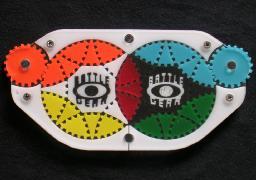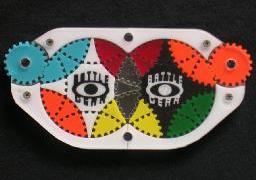Battle Gear
Battle Gear is an extremely difficult puzzle consisting of two overlapping circular
disks, reminiscent of other circle puzzles such as Turnstile
and Rashkey. Instead of the 6-fold or 4-fold symmetry of
those puzzles, Battle Gear has 8 fold symmetry. The left disk has an octagonal
centre, 8 pointy triangular pieces (Points) arranged around the centre forming
a star shape, and 8 wide triangular pieces (Axes) between the Points. The overlap
of the two disks contains two Axe pieces and one Point piece. The right hand disk
is similarly made up of a centre, 8 Points, and 8 Axe pieces but note that the Point
piece in the intersection is pointing the wrong way for the right disk. In fact,
every Point piece of one disk will be pointing the wrong way for the other disk, so
as the puzzle gets mixed, Point pieces will be moved from one disk to the other, and
cause some moves to be blocked.
These puzzles were invented by Douglas A. Engel, who also invented various
other puzzles such as:
The number of positions:
First we need to count the number of configurations, i.e. the number of positions
if the pieces were all the same colour. Each configuration is determined by the
arrangement of the Point pieces. Note that two Points belonging to one disk cannot
lie adjacent in the oher disk. I will also assume that the configuration is such
that both disks can still rotate.
If the intersection contains a Point of the left disk, then the left disk can
have three, two, one or no right Points, and these can be arranged in 1, 5, 5, and
1 ways respectively. The same holds for the right disk, giving 1·1 +
5·5 + 5·5 + 1·1 = 52 configurations. If the intersection
instead contains a right Point piece, the number of configurations is 1·5 +
5·5 + 5·1 = 35. For a total of 87 configurations.
The orientation of the two centre pieces is visible, and they each have 8
orientations.
There are 8 left Points, 7 right Points, 8 left Axes, and 6 right Axe pieces.
The two sets of Point pieces can be rearranged in any manner, but their total
permutation must be even. Each set of Axe pieces can only undergo even permutations.
Putting this all together, we get
87 · 8
2 · (8!·7!)/2 · 8!/2 · 6!/2
= 4,105,946,812,907,520,000 positions if all pieces were distinct.
Below is a table showing the number of positions of the various versions.
|
Name |
Left Points |
Right Points |
Left Axes |
Right Axes |
Positions calculation |
Result |
 |
Mask 1 |
3+2+2+1 |
3+2+2 |
3+3+2 |
3+3 |
87 · 82 · 8!/(2!23!) · 7!/(2!23!) · 8!/(3!22!) · 6!/3!2 |
22,001,172,480,000 |
 |
Mask 2 |
4+2+2 |
3+2+2 |
3+3+2 |
3+3 |
87 · 82 · 8!/(2!24!) · 7!/(2!23!) · 8!/(3!22!) · 6!/3!2 |
5,500,293,120,000 |
 |
Spy |
3+1+1+1+1+1 |
3+1+1+1+1 |
2+2+2+1+1 |
2+2+1+1 |
87 · 82 · 8!/3! · 7!/3! · 8!/2!3 · 6!/2!2 |
28,513,519,534,080,000 |
 |
Attack |
3+1+1+1+1+1 |
3+1+1+1+1 |
2+2+2+2 |
2+2+1+1 |
87 · 82 · 8!/3! · 7!/3! · 8!/2!4 · 6!/2!2 |
14,256,759,767,040,000 |
 |
Dismissed |
7+1 |
7 |
6+2 |
6 |
87 · 82 · 8!/7! · 8!/(6!2!) |
1,247,232 |
 |
Flanked |
5+1+1+1 |
4+1+1+1 |
2+2+2+2 |
2+2+2 |
87 · 82 · 8!/5! · 7!/4! · 8!/2!4 · 6!/2!3 |
89,104,748,544,000 |
 |
Skirmish |
6+1+1 |
6+1 |
4+2+2 |
4+2 |
87 · 82 · 8!/6! · 7!/6! · 8!/(2!24!) · 6!/(2!4!) |
13,750,732,800 |
Links to other useful pages:
PuzzleAtomic.com is the homepage of Douglas Engel, the inventor and manufacturer.
Solution:
This solution works on all versions, because it
assumes that all pieces are distinct. On any particular version of the puzzle
there will therefore usually exist shorter move sequences that seem to have
the same effect as the ones given here.
Notation:
Let a clockwise 45 degree rotation (1/8th of a full circle) of the left disk
be denoted by L1. Rotations of 90, 135, 180, 225, 270, 315 degrees are then
denoted by L2, L3, L4, L5, L6, and L7. Note that L7 can also be considered an
anti-clockwise 45 degree turn. Turns of the right disk are denoted in the same
way, but using the letter R.
Phase 1: Create the correct configuration.
- If the left disk does not contain any Point pieces that point the wrong way, then go to step e.
- Rotate the left disk to bring the reversed Point piece to the intersection.
- The right disk must contain a reversed Point piece.
Rotate the right disk to bring the reversed Point piece to the intersection.
- Repeat a-c until all the Point pieces are pointing correctly.
- Examine what R turn would correctly orient the right centre,
and do the corresponding move sequence below:
R2 turn of centre: R2 L4 R6 L4 R2
R3 turn of centre: R3 L4 R5 L4 R3
R4 turn of centre: R4 L4 R4 L4 R4
R5 turn of centre: R5 L4 R3 L4 R5
R6 turn of centre: R6 L4 R2 L4 R6
For an R1 or R7 turn of the centre, just do any one of the above and then try again.

Phase 2: Solve the Point pieces of the right disk.
This phase uses 6 move sequences, each of which swaps the Point piece on the
right hand side of the right disk with one of the other ones:
Top-left: R2 L2 R2 L2 R4 L4 R7 L2 R1 L2 R2 L6 R2 L6 R4
Top: R6 L2 R6 L6 R2 L2 R2
Top-right: R2 L2 R2 L6 R1 L2 R7 L6 R6 L2 R6
Bottom-right: R6 L2 R6 L6 R7 L2 R1 L6 R2 L2 R2
Bottom: R2 L2 R2 L6 R6 L2 R6
Bottom-left: R6 L2 R6 L2 R4 L4 R1 L2 R7 L2 R6 L6 R6 L6 R4
- If the Point piece currently at the right
hand side of the right disk is not of the correct colour, then find out
at which location it belongs. Use the appropriate sequence above to
put it into that correct location.
- If the Point piece currently at the right
hand side of the right disk is already of the correct colour, then find
any incorrect Point piece of the right disk of a different colour. Use
the appropriate sequence above to bring to the right hand side.
- Repeat a-b until all the Point pieces of the
right disk are correct.

Phase 3: Solve the Axe pieces of the right disk.
- Find the Axe piece that belongs at the top-left
location of the right disk. If it lies at the bottom-left of the right disk,
then do the sequence from step c, otherwise do:
R6 L2 R5 L6 R1 L2 R7 L6 R1 L2 R7 L6 R1 L2 R2 L6 R2
- Repeat step a until the correct Axe piece
lies at the top-left location.
- If the location at the bottom-left of the right disk
does not have the correct Axe piece, do:
R2 L2 R3 L6 R7 L2 R1 L6 R7 L2 R1 L6 R7 L2 R6 L6 R6
- Repeat step c until the correct Axe piece
lies at the bottom-left location.
- Find the Axe piece that belongs at the top-right
location of the right disk. If it lies at the bottom-right of the right disk,
then do the sequence from step f, otherwise do:
R6 L2 R5 L6 R7 L2 R1 L2 R3 L6 R7 L2 R6 L6 R7 L6 R1 L2 R2 L6 R3
- Repeat step e until the correct Axe piece
lies at the top-right location.
- If the location at the bottom-right of the right disk
does not have the correct Axe piece, do:
R2 L2 R3 L6 R1 L2 R7 L2 R5 L6 R1 L2 R2 L6 R1 L6 R7 L2 R6 L6 R5
- Repeat step f until the correct Axe piece
lies at the bottom-right location.

Phase 4: Solve the Point pieces of the left disk.
The following sequence is a 3-cycle of the left-most Point pieces
of the left disk:
R2 L3 R6 L1 R2 L1 R6 L6 R2 L5 R6
With this sequence it is relatively straightforward to solve the left Points, because
you can use it to cycle any three adjacent Points of the left disk. Remember to put
the left centre in the correct orientation before determining how to move the pieces.

Phase 5: Solve the Axe pieces of the left disk.
The following sequence is a 3-cycle of the two Axe pieces in the intersection and
the bottom-right Axe of the left disk:
L1 R2 L5 R6 L7 R2 L1 R2 L3 R6 L7 R2 L6 R6 L7 R6 L1 R2 L2 R6
With this sequence it is relatively straightforward to solve the left Axes, because
you can use it to cycle any three adjacent Axes of the left disk.














